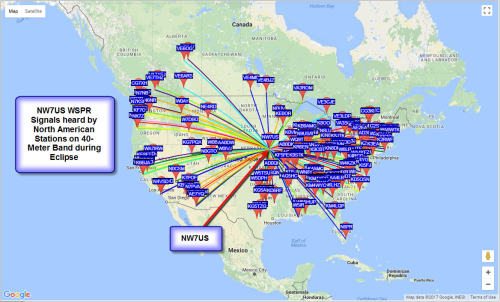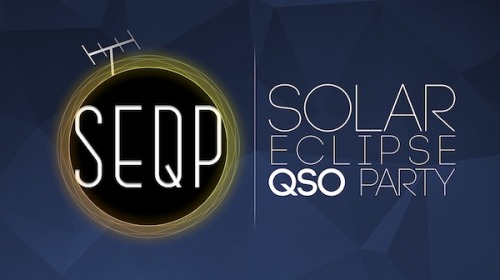Yes, an Eclipse Affects Radiowave Propagation

Does an eclipse change the dynamics of the propagation of radio waves via ionospheric refraction? In other words, does a passing eclipse affect shortwave radio propagation? Will lower-frequency radio signals go farther, or at least will the reception of these signals improve? What about on higher shortwave frequencies? (If you want to learn all about space weather, the ionosphere, the geomagnetic field, and the propagation of shortwave radiowave signals, get the course at http://NW7US.us/swc).
Below are two maps, each showing the amateur-radio stations receiving my transmission of a digital mode known as, ‘WSPR’ (pronounced, 'whisper’), which stands for 'Weak-Signal Propagation Reporter.’ In actuality, the mode is MEPT_JT which started life in 2008 as a suggestion by Murray Greenman CSc, a New Zealand amateur radio operator with a call sign of ZL1BPU (and ZL1EE). Joe Taylor, who is also an amateur radio operator with a FCC-assigned call sign of K1JT, implemented this mode in his now-infamous software WSJT(-X). Joe is Joseph Hooton Taylor Jr., an American astrophysicist and Nobel Prize in Physics laureate for his discovery with Russell Alan Hulse of a “new type of pulsar, a discovery that has opened up new possibilities for the study of gravitation.”
The WSPR mode is used by volunteer amateur-radio and shortwave-listening operators who tune to predesignated frequencies in the established and legal amateur-radio allocations throughout the shortwave radio spectrum. These stations make up what is called, 'The Weak Signal Propagation Reporter Network,’ or, 'WSPRnet.’ This network probes radio frequency propagation conditions using low- and very-low-power transmissions.
My transmission was a ten-watt shortwave signal transmitted on a frequency located in the forty-meter band. I started my radio transmissions early in the day of the eclipse. I ended the communications a few hours after the eclipse.
This first map shows the stations that were reporting my signal as received by each station, during the time that the moon casts its shadow over Nebraska. Those stations hearing my WSPR signals automatically sent their reception report to a centralized database dedicated to the WSPR mode. The database is front-ended by a map, on which these stations and reports are plotted. You can see maps like these at this URL: the Weak Signal Propagation Reporter Network. My station, located in Omaha, Nebraska, is plotted at the very center of this map:

This next map shows the stations receiving my WSPR signals soon after daylight returned at my radio station’s location. Clearly, the difference in ionospheric propagation of the 7038.6 kHz shortwave signals is markedly different! The footprint of my signal was coast-to-coast and even up into Canada during the eclipse (first map). But, the footprint of my transmissions contracted to a tiny region, as seen below:

Why is this difference so dramatic? What is it about an eclipse of our Sun that drastically alters ionospheric properties, as noticed in the propagation of a shortwave radio signal? In the second part of this two-part series, I’ll go into the science of this phenomenon.
My participation in the WSPRnet activity during the solar eclipse of 2017 was connected with the Solar Eclipse QSO Party as described at the HamSCI-ARRL sponsored operating event web page.

If you want to learn all about space weather, the ionosphere, the geomagnetic field, and the propagation of shortwave radiowave signals, get the course at http://NW7US.us/swc.
